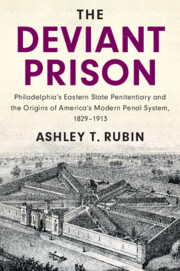 The Deviant Prison
The Deviant Prison Book contents
- Frontmatter
- Contents
- List of Figures
- List of Tables
- Acknowledgements
- List of Abbreviations
- A Brief Timeline
- Important Actors
- Introduction
- Part I Becoming the Deviant Prison: Establishing The Conditions for Personal Institutionalization
- Part II THE ADVANTAGE OF DIFFERENCE: The Process of Institutionalization
- 5 Neutralizing the Calumnious Myths: Administrators’ Public Defense of the Pennsylvania System
- 6 Combatting the Pains of Deviance: Organizational Defense As Self-Defense
- B Behind the Scenes
- 7 Strategic Manipulations: Acceptable and Unacceptable Violations of the Pennsylvania System
- 8 Turning a Blind Eye: Reputation and the Limits of Administrative Commitment
- Part III Forced to Adapt: The Conditions for and Process of Deinstitutionalization
- Appendix A Inspectors
- Index
6 - Combatting the Pains of Deviance: Organizational Defense As Self-Defense
from Part II - THE ADVANTAGE OF DIFFERENCE: The Process of Institutionalization
Published online by Cambridge University Press: 12 January 2021
- Frontmatter
- Contents
- List of Figures
- List of Tables
- Acknowledgements
- List of Abbreviations
- A Brief Timeline
- Important Actors
- Introduction
- Part I Becoming the Deviant Prison: Establishing The Conditions for Personal Institutionalization
- Part II THE ADVANTAGE OF DIFFERENCE: The Process of Institutionalization
- 5 Neutralizing the Calumnious Myths: Administrators’ Public Defense of the Pennsylvania System
- 6 Combatting the Pains of Deviance: Organizational Defense As Self-Defense
- B Behind the Scenes
- 7 Strategic Manipulations: Acceptable and Unacceptable Violations of the Pennsylvania System
- 8 Turning a Blind Eye: Reputation and the Limits of Administrative Commitment
- Part III Forced to Adapt: The Conditions for and Process of Deinstitutionalization
- Appendix A Inspectors
- Index
Summary
The annual reports represent the principal medium through which the administrators presented and defended their embattled prison against claims that the Pennsylvania System was expensive, cruel and inhumane, ineffective, and impracticable. These claims defended both the Pennsylvania System and the men who implemented it. In challenging the myths’ veracity, Eastern's administrators relied on what criminologists Gresham Sykes and David Matza call “techniques of neutralization,” a series of accounts of their behavior that challenge the fact of, or mitigate responsibility or blame for, immoral or inappropriate behavior. This chapter explores three such strategies: changing how they described the Pennsylvania System, denying the existence of bad outcomes, and denying the system's responsibility for bad outcomes that did occur by placing the blame on others. Ultimately, these techniques of neutralization enabled Eastern's administrators to neutralize the pains of deviance and sustain the Pennsylvania System despite the criticism. Defending against the myths in this way also created a context for the Pennsylvania System to become personally institutionalized for Eastern's administrators.
Keywords
- Type
- Chapter
- Information
- The Deviant PrisonPhiladelphia's Eastern State Penitentiary and the Origins of America's Modern Penal System, 1829–1913, pp. 171 - 198Publisher: Cambridge University PressPrint publication year: 2021


